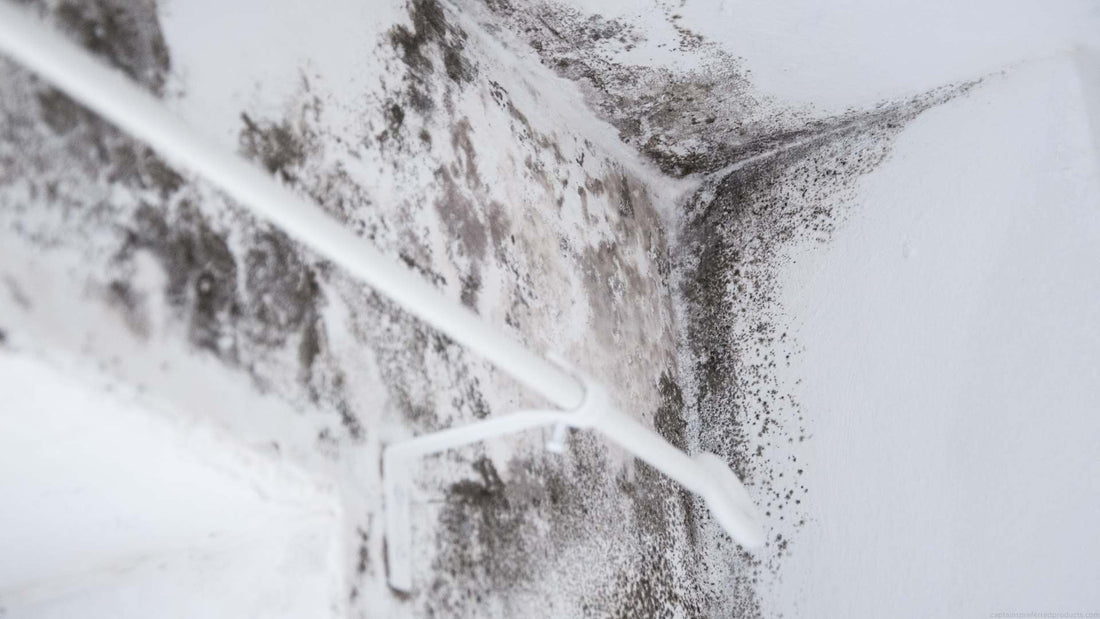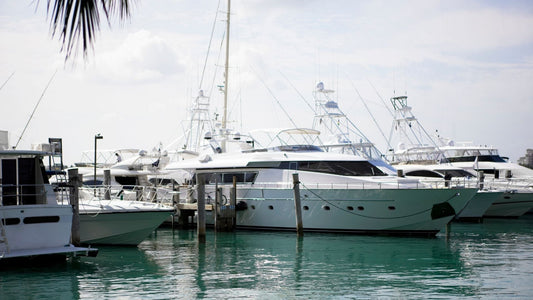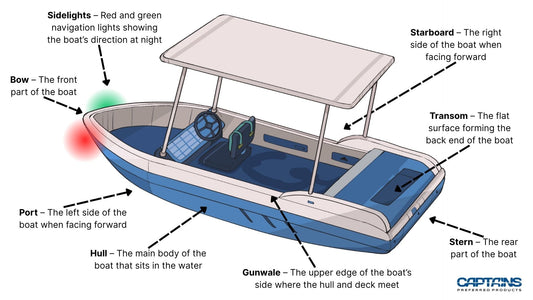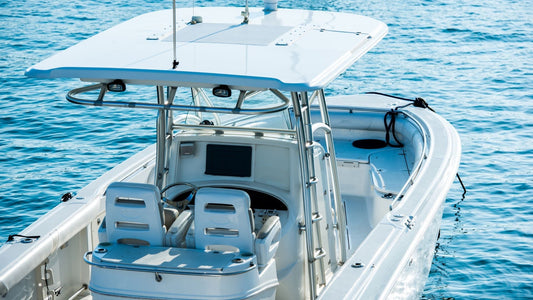
Boat Mold and Mildew: What Causes It and How to Eliminate It for Good
Nicholas HeislerShare
Whether you’re a seasoned sailor or a weekend water warrior, one of the most frustrating and stubborn problems boaters face is mold and mildew. These pesky fungi aren’t just unsightly — they can be a health hazard, cause unpleasant odors, and even damage your boat's interior and structure over time.
Understanding what causes mold and mildew on your vessel — and knowing how to eliminate and prevent it — is key to keeping your boat clean, safe, and in top condition. In this guide, we’ll cover everything you need to know, from the causes and dangers to cleaning tips and long-term prevention strategies.
Understanding Mold and Mildew on Boats
Before we dive into the solutions, let’s define what we’re dealing with.
Mildew is a type of fungus that appears as a thin, white or grayish powdery layer — often on surfaces like vinyl or canvas. Mold, on the other hand, is usually darker (black, green, or blue), thicker, and can grow deeper into porous materials like foam, wood, and fabric.
Because boats operate in wet, humid environments, they create the perfect conditions for mold and mildew to thrive. Add in a few dark storage compartments, lingering moisture from the last trip, and a bit of organic residue — and you’ve got a breeding ground for fungal growth.
What Causes Mold and Mildew on Boats?
Mold and mildew need just three things to flourish: moisture, warmth, and organic material. Boats, unfortunately, offer all three in abundance.
1. High Humidity and Poor Ventilation
Cabins and compartments without adequate airflow trap humid air, allowing moisture to settle and feed fungal growth.
2. Water Intrusion and Condensation
Leaks in windows, hatches, or bilges, combined with morning condensation or leftover water from a day on the water, often go unnoticed — until mold sets in.
3. Organic Residue
Skin oils, food crumbs, sunscreen, fish blood, and dirt all serve as food sources for mold and mildew. When not cleaned up promptly, they provide the perfect launching pad for spores.
4. Infrequent Use and Cleaning
Boats left idle for long stretches are especially vulnerable. Closed compartments and lack of ventilation make things worse.
How to Identify Mold and Mildew Early
Early detection is key to minimizing damage and keeping your boat healthy. Here’s what to look for:
-
Visual Cues: Mold typically looks fuzzy or slimy and can be black, green, brown, or even orange. Mildew is often powdery and white or gray.
-
Smell: That unmistakable musty, sour odor is often the first sign that something’s growing where it shouldn’t.
-
Tactile Clues: Surfaces that feel sticky or damp may be harboring hidden mold beneath the surface.
-
Hidden Spots: Check behind cushions, under carpeting, in lockers, storage bins, and around the bilge and headliner.
The Health and Structural Risks of Mold on Boats
Ignoring mold and mildew can lead to more than just cosmetic issues.
Health Risks
Mold spores can trigger allergies, asthma, and respiratory infections — particularly dangerous in enclosed cabin spaces where ventilation is limited.
Structural Damage
Left unchecked, mold can rot wood, eat into vinyl, stain fabrics permanently, and cause corrosion in metal fixtures. Mold also breaks down adhesives, which can loosen linings, padding, and flooring over time.
Step-by-Step: How to Remove Mold and Mildew from Your Boat
Ready to tackle the mess? Here’s a tried-and-true removal method:
Step 1: Gear Up for Safety
Wear gloves, goggles, and a mask to avoid inhaling spores or coming into contact with cleaners.
Step 2: Choose the Right Cleaner
Choose a cleaner that is specially formulated for handling marine surfaces. These mildew removers will handle the buildup while protecting your boat surfaces.
Step 3: Scrub Thoroughly
-
Use a soft brush or sponge to apply your cleaner.
-
Let the product sit for several minutes (or as instructed).
-
Scrub gently but thoroughly — pay attention to seams and stitching on cushions or canvas.
-
For carpets or upholstery, use a wet-dry vacuum to extract moisture after cleaning.
Step 4: Rinse and Dry
- Rinse all surfaces with clean water.
-
Use towels or a wet/dry vac to remove as much moisture as possible.
-
Let everything air dry in a well-ventilated space — ideally in the sun, which helps kill remaining spores.
Step 5: Disinfect
After cleaning, consider a disinfectant spray like isopropyl alcohol or marine-safe sanitizers to kill lingering microbes.
Best Products for Removing Boat Mold and Mildew
When it comes to tackling mold and mildew on your boat, using high-quality, marine-grade products is essential. Here are the top recommendations:
1. Captain’s Fury Mildew Stain Remover
This powerful cleaner is your first line of defense against stubborn mildew stains. Designed for marine use, it cuts through buildup on vinyl, fiberglass, rubber, and non-porous surfaces without damaging your boat's finish. Simply spray, let it sit, and wipe — no heavy scrubbing required.
2. Star brite Mold & Mildew Stain Remover: A strong, fast-acting option for stains on vinyl, rubber, and fiberglass.
3. 303 Mold & Mildew Cleaner + Blocker: Effective and safe for use on delicate marine fabrics and upholstery.
4. Concrobium Mold Control: Non-toxic and great for long-term prevention after initial cleaning.
Preventing Mold and Mildew from Coming Back
Once your boat is clean, the goal is to keep it that way. Here’s how to make mold prevention part of your regular maintenance routine:
1. Improve Ventilation
Install solar-powered vents, crack open hatches when docked, or add a small 12V fan to circulate air inside closed cabins.
2. Use Moisture Absorbers
Products like DampRid, silica gel packs, or dehumidifiers (especially if your boat is stored indoors) help control moisture levels.
3. Clean and Dry Regularly
-
After each outing, wipe down all wet areas.
-
Remove and air out cushions and rugs.
-
Use a squeegee in enclosed spaces like the head or galley.
4. Choose Mold-Resistant Materials
Opt for mildew-resistant fabrics, marine vinyl, and sealed wood when updating your interior. Use protective sprays on soft surfaces.
5. Store Properly
-
Use breathable boat covers or shrink wrap with vents during off-season.
-
Keep lockers open slightly to encourage air circulation.
-
Store gear dry and clean before sealing it in compartments.
Mold and Mildew Prevention Checklist
Here’s a quick reference you can use every time you wrap up a boating trip or prepare for storage:
-
Dry out all compartments and bilges
-
Wipe down seats, cushions, and decks
-
Remove wet gear and towels immediately
-
Open hatches or vents for airflow
-
Use moisture absorbers or desiccant packs
-
Clean spills and food debris right away
-
Inspect for leaks and seal them promptly
-
Treat fabrics with mold-resistant sprays
-
Schedule deep cleans monthly or quarterly
When to Call a Professional
Sometimes, mold goes beyond DIY solutions. If you notice:
-
Mold in inaccessible areas like behind walls or under decking
-
Significant rot or structural damage
-
Persistent odors even after cleaning
-
Health issues after spending time onboard
…it’s time to bring in a professional marine mold remediation service. They have industrial-grade tools and knowledge to address serious infestations without damaging your vessel.
Ready to Handle Mold and Mildew on Your Boat?
Mold and mildew may be a persistent enemy for boaters, but with the right knowledge and tools, you can fight back — and win. By understanding what causes these fungi, how to clean them effectively, and how to prevent them from coming back, you’ll enjoy a healthier, fresher, and longer-lasting boating experience.
A clean boat isn’t just about looks — it’s about safety, value, and peace of mind. Take the time to stay ahead of mold, and your boat will thank you for it.
To keep your entire boat clean, try Captain's Fury boat cleaners. With a full line of powerful marine formulas, they have everything you need to keep your boat in tip-top condition all season long.




